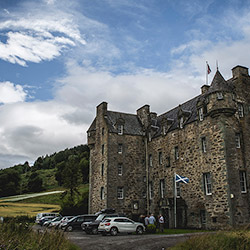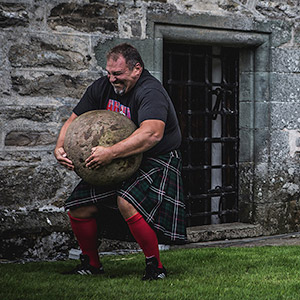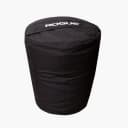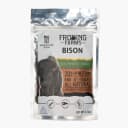

Published: February 15, 2019 | Updated: September 27, 2024
There are few places on earth as intimately tied to historic feats of strength as the Highlands of Scotland. Lifting stones, formed over centuries by wind and river erosion, can be found all over Scotland – each with its own history and local lore.
ON LOCATION
Explore the map to learn more about the landmarks visited in the film.



PUDRAC STONE
130MI/209KM from P&J Live
Located in Balquhidder and weighing about 200 lbs, the Pudrac Stone is to be lifted onto a plinth as a test of strength and championship. It sits in a field next to the grave site of Rob Roy McGregor, a Scottish folk hero often compared to Robin Hood.

FIANNA STONE
113MI/182KM from P&J Live
The Fianna Stone rests in a Glen in Glenlyon Perthshire, Scotland. According to local legend, the 280 lb. Fianna Stone was used as an ancient testing stone for the Fianna Warriors who protected their land from foreign invaders.
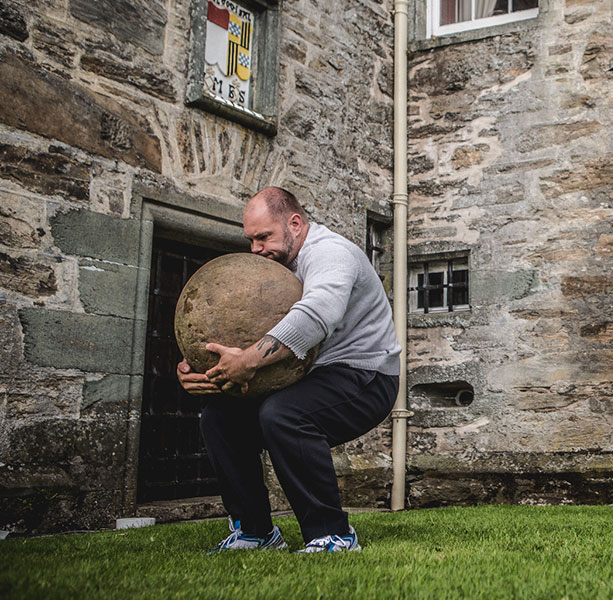
THE CHIEFTAINS STONE (MENZIES STONE)
133MI/214KM from P&J Live
Located outside of Castle Menzies, the Chieftains Stone is 250 lbs — 15 lbs lighter than the Inver Stone — but is considered one of the more difficult strength stones. The stone is an archetypal Pullaid, the old Gaelic word for globe lifting stone. For this reason, many consider its popularity related to the fact that it resembles an ancient Atlas Stone. The first mention of it being lifted dates back to 1840, as a test for the immensely strong bodyguards of the Clan’s Chief.

DALWHINNIE STONE
116MI/186KM from P&J Live
The Dalwhinnie Stone sits outside a cafe at the Loch Ericht Hotel in Dalwhinnie, Scotland. It is said that when lifted, “the Dalwhinnie stone travels further to the heavens than any other Scottish stone” as Dalwhinnie boasts the highest elevation in Scotland. At 240 lbs, the Dalwhinnie stone is slightly lighter than the Inver stone but just as difficult to lift due to its smooth and rounded shape.

BAREVAN STONE
89MI/143KM from P&J Live
The Barevan Stone sits outside the ruins of the old Barevan church and Kirkton of Barevan in Cawdor, Scotland. According to local legend, the 250 lb stone and the stone coffin in which it sits were used as a form of punishment for church parishioners who broke the rules — they would be forced to lie in the coffin and a now-missing stone slab was laid on top of them for the duration of their punishment.
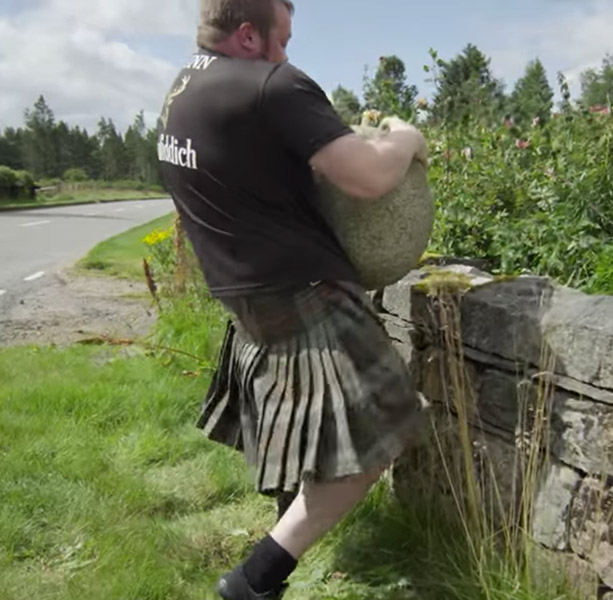
THE INVER STONE
55MI/89KM from P&J Live
The 265 lb Inver Stone sits outside a cottage in Crathie, Scotland and since 1947 has been looked after by the property’s caretaker, Mrs. June Richards. Like the Dinnie Stones, the Inver Stone is immensely popular and travelers come from all over the world to attempt to lift it. The true age of the stone is difficult to discern though experts maintain that attempts to lift it predate the construction of the Inver Hotel, which was built in 1760.

THE ABOYNE HIGHLAND GAMES
The 140-year-old Aboyne Highland Games take place on the Aboyne Green, situated in the center of the village of Aboyne. The origin of the games dates back to the 18th century when the Laird of Grant sent a summons to 600 of his people to be ready for a gathering of “hoisting and hunting” as well as military exercises. Today, traditional events include the hammer toss, putting stone, ring over the bar, tug of war and weight carry, as well as dance and performance competition.

THE DINNIE STONES
24MI/38.5KM from P&J Live
Weighing 318 lbs and 414 lbs, the Dinnie Stones are considered the most famous in all of Scotland and maybe the world, depending on who you ask. They get their name from a 23-year-old Donald Dinnie who lifted them in 1860 and “carried them across the bridge and back, some four to five yards,” according to Dinnie himself. Strength historian David Webster discovered the stones near the Potarch Bridge over the River Dee. The stones are unique in that they have iron ringed handles and are to be lifted in unison.

PUDRAC STONE
130MI/209KM from P&J Live
Located in Balquhidder and weighing about 200 lbs, the Pudrac Stone is to be lifted onto a plinth as a test of strength and championship. It sits in a field next to the grave site of Rob Roy McGregor, a Scottish folk hero often compared to Robin Hood.

FIANNA STONE
113MI/182KM from P&J Live
The Fianna Stone rests in a Glen in Glenlyon Perthshire, Scotland. According to local legend, the 280 lb. Fianna Stone was used as an ancient testing stone for the Fianna Warriors who protected their land from foreign invaders.

THE CHIEFTAINS STONE (MENZIES STONE)
133MI/214KM from P&J Live
Located outside of Castle Menzies, the Chieftains Stone is 250 lbs — 15 lbs lighter than the Inver Stone — but is considered one of the more difficult strength stones. The stone is an archetypal Pullaid, the old Gaelic word for globe lifting stone. For this reason, many consider its popularity related to the fact that it resembles an ancient Atlas Stone. The first mention of it being lifted dates back to 1840, as a test for the immensely strong bodyguards of the Clan’s Chief.

DALWHINNIE STONE
116MI/186KM from P&J Live
The Dalwhinnie Stone sits outside a cafe at the Loch Ericht Hotel in Dalwhinnie, Scotland. It is said that when lifted, “the Dalwhinnie stone travels further to the heavens than any other Scottish stone” as Dalwhinnie boasts the highest elevation in Scotland. At 240 lbs, the Dalwhinnie stone is slightly lighter than the Inver stone but just as difficult to lift due to its smooth and rounded shape.

BAREVAN STONE
89MI/143KM from P&J Live
The Barevan Stone sits outside the ruins of the old Barevan church and Kirkton of Barevan in Cawdor, Scotland. According to local legend, the 250 lb stone and the stone coffin in which it sits were used as a form of punishment for church parishioners who broke the rules — they would be forced to lie in the coffin and a now-missing stone slab was laid on top of them for the duration of their punishment.

THE INVER STONE
55MI/89KM from P&J Live
The 265 lb Inver Stone sits outside a cottage in Crathie, Scotland and since 1947 has been looked after by the property’s caretaker, Mrs. June Richards. Like the Dinnie Stones, the Inver Stone is immensely popular and travelers come from all over the world to attempt to lift it. The true age of the stone is difficult to discern though experts maintain that attempts to lift it predate the construction of the Inver Hotel, which was built in 1760.

THE ABOYNE HIGHLAND GAMES
The 140-year-old Aboyne Highland Games take place on the Aboyne Green, situated in the center of the village of Aboyne. The origin of the games dates back to the 18th century when the Laird of Grant sent a summons to 600 of his people to be ready for a gathering of “hoisting and hunting” as well as military exercises. Today, traditional events include the hammer toss, putting stone, ring over the bar, tug of war and weight carry, as well as dance and performance competition.

THE DINNIE STONES
24MI/38.5KM from P&J Live
Weighing 318 lbs and 414 lbs, the Dinnie Stones are considered the most famous in all of Scotland and maybe the world, depending on who you ask. They get their name from a 23-year-old Donald Dinnie who lifted them in 1860 and “carried them across the bridge and back, some four to five yards,” according to Dinnie himself. Strength historian David Webster discovered the stones near the Potarch Bridge over the River Dee. The stones are unique in that they have iron ringed handles and are to be lifted in unison.
STORIES OF THE STONES

BAREVAN STONE

CHIEFTAN STONE

DALWHINNIE STONE

DINNIE STONES

FIANNA STONE

INVER STONE

PUDRAC STONE
Image Gallery
